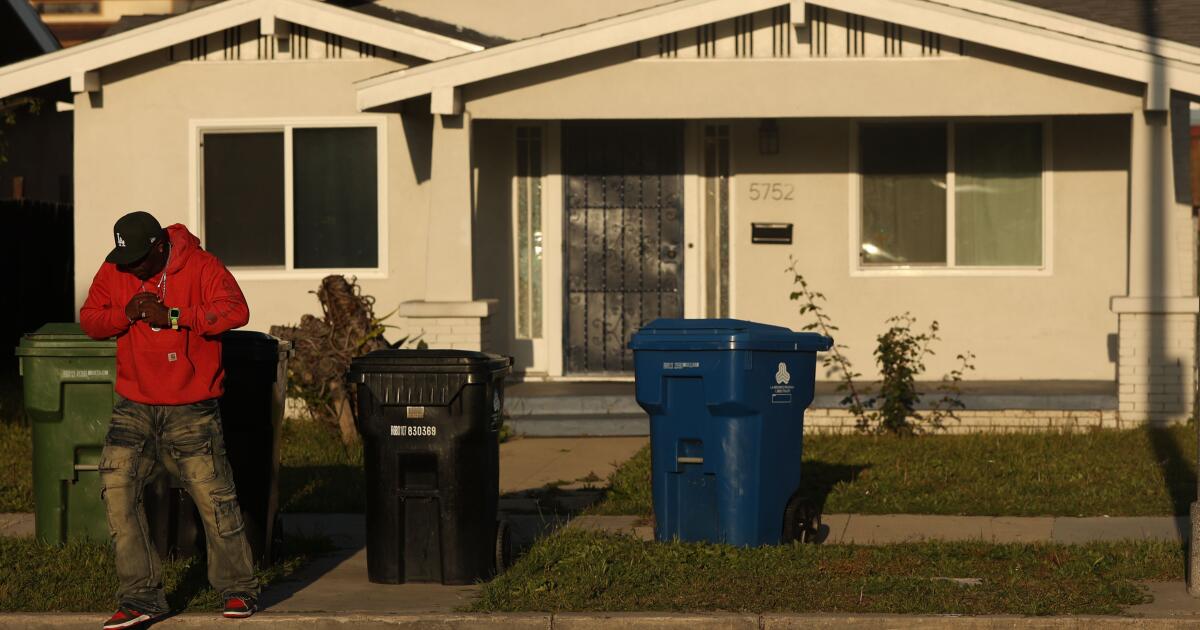Asylum seekers face deportation over failure to pay new fees — before being notified
WASHINGTON — Late last month, an immigrant seeking asylum in the U.S. came across social media posts urging her to pay a new fee imposed by the Trump administration before Oct. 1, or else risk her case being dismissed.
Paula, a 40-year-old Los Angeles-area immigrant from Mexico, whose full name The Times is withholding because she fears retribution, applied for asylum in 2021 and her case is now on appeal.
But when Paula tried to pay the $100 annual fee, she couldn’t find an option on the immigration court’s website that accepted fees for pending asylum cases. Afraid of deportation — and with just five hours before the payment deadline — she selected the closest approximation she could find, $110 for an appeal filed before July 7.
She knew it was likely incorrect. Still, she felt it was better to pay for something, rather than nothing at all, as a show of good faith. Unable to come up with the money on such short notice, Paula, who works in a warehouse repairing purses, paid the fee with a credit card.
“I hope that money isn’t wasted,” she said.
That remains unclear because of confusion and misinformation surrounding the rollout of a host of new fees or fee increases for a variety of immigration services. The fees are part of the sweeping budget bill President Trump signed into law in July.
Paula was one of thousands of asylum seekers across the country who panicked after seeing messages on social media urging them to pay the new fee before the start of the new fiscal year on Oct. 1.
But government messaging about the fees has sometimes been chaotic and contradictory, immigration attorneys say. Some asylum seekers have received notice about the fees, while others have not. Misinformation surged as immigrants scrambled to figure out whether, and how, to pay.
Advocates worry the confusion serves as a way for immigration officials to dismiss more asylum cases, which would render the applicants deportable.
The fees vary. For those seeking asylum, there is a $100 fee for new applications, as well as a yearly fee of $100 for pending applications. The fee for an initial work permit is $550 and work permit renewals can be as much as $795.
Amy Grenier, associate director of government relations at the American Immigration Lawyers Assn., said that not having a clear way to pay a fee might seem like a small government misstep, but the legal consequences are substantial.
For new asylum applications, she said, some immigration judges set a payment deadline of Sept. 30, even though the Executive Office for Immigration Review only updated the payment portal in the last week of September.
“The lack of coherent guidance and structure to pay the fee only compounded the inefficiency of our immigration courts,” Grenier said. “There are very real consequences for asylum-seekers navigating this completely unnecessary bureaucratic mess.”
Two agencies collect the asylum fees: U.S. Citizenship and Immigration Services (USCIS), under the Department of Homeland Security, and the Executive Office for Immigration Review (EOIR), under the Department of Justice, which operates immigration courts.
Both agencies initially released different instructions regarding the fees, and only USCIS has provided an avenue for payment.
The departments of Homeland Security and Justice didn’t respond to a request for comment. The White House deferred to USCIS.
USCIS spokesman Matthew J. Tragesser said the asylum fee is being implemented consistent with the law.
“The real losers in this are the unscrupulous and incompetent immigration attorneys who exploit their clients and bog down the system with baseless asylum claims,” he said.
The Asylum Seeker Advocacy Project (ASAP), a national membership organization, sued the Trump administration earlier this month after thousands of members shared their confusion over the new fees, arguing that the federal agencies involved “threaten to deprive asylum seekers of full and fair consideration of their claims.”
The organization also argued the fees shouldn’t apply to people whose cases were pending before Trump signed the budget package into law.
In a U.S. district court filing Monday, Justice Department lawyers defended the fees, saying, “Congress made clear that these new asylum fees were long overdue and necessary to recover the growing costs of adjudicating the millions of pending asylum applications.”
Some of the confusion resulted from contradictory information.
A notice by USCIS in the July 22 Federal Register confused immigrants and legal practitioners alike because of a reference to Sept. 30. Anyone who had applied for asylum as of Oct. 1, 2024, and whose application was still pending by Sept. 30, was instructed to pay a fee. Some thought the notice meant that Sept. 30 was the deadline to pay the yearly asylum fee.
By this month, USCIS clarified on its website that it will “issue personal notices” alerting asylum applicants when their annual fee is due, how to pay it and the consequences for failing to do so.
The agency created a payment portal and began sending out notices Oct. 1, instructing recipients to pay within 30 days.
But many asylum seekers are still waiting to be notified by USCIS, according to ASAP, the advocacy organization. Some have received texts or physical mail telling them to check their USCIS account, while others have resorted to checking their accounts daily.
Meanwhile the Executive Office for Immigration Review (EOIR) didn’t add a mechanism for paying the $100 fee for pending asylum cases — the one Paula hoped to pay — until Thursday.
In its Oct. 3 complaint, lawyers for ASAP wrote: “Troublingly, ASAP has received reports that some immigration judges at EOIR are already requiring applicants to have paid the annual asylum fee, and in at least one case even rejected an asylum application and ordered an asylum seeker removed for non-payment of the annual asylum fee, despite the agency providing no way to pay this fee.”
An immigration lawyer in San Diego, who asked not to be named out of fear of retribution, said an immigration judge denied his client’s asylum petition because the client had not paid the new fee, even though there was no way to pay it.
The judge issued an order, which was shared with The Times, that read, “Despite this mandatory requirement, to date the respondents have not filed proof of payment for the annual asylum fee.”
The lawyer called the decision a due process violation. He said he now plans to appeal to the Board of Immigration Appeals, though another fee increase under Trump’s spending package raised that cost from $110 to $1,010. He is litigating the case pro bono.
Justice Department lawyers said Monday that EOIR had eliminated the initial inconsistency by revising its position to reflect that of USCIS and will soon send out official notices to applicants, giving them 30 days to make the payment.
“There was no unreasonable delay here in EOIR’s implementation,” the filing said. “…The record shows several steps were required to finalize EOIR’s process, including coordination with USCIS. Regardless, Plaintiff’s request is now moot.”
Immigrants like Paula, who is a member of ASAP, recently got some reassurance. In a court declaration, EOIR Director Daren Margolin wrote that for anyone who made anticipatory or advance payments for the annual asylum fee, “those payments will be applied to the alien’s owed fees, as appropriate.”


